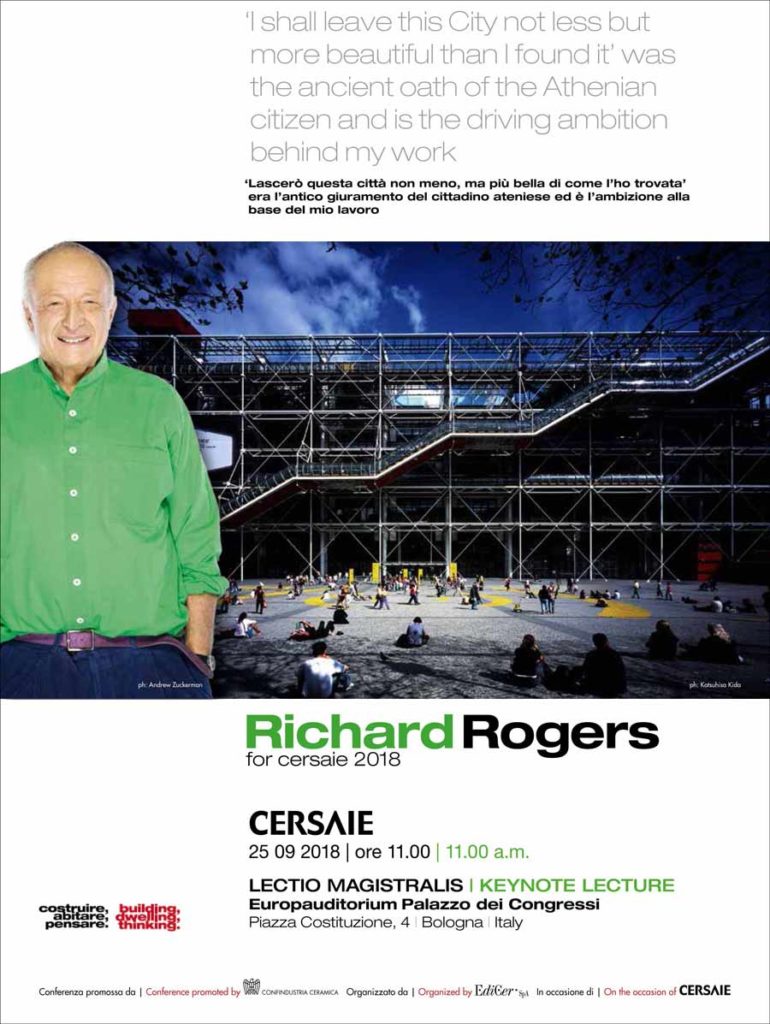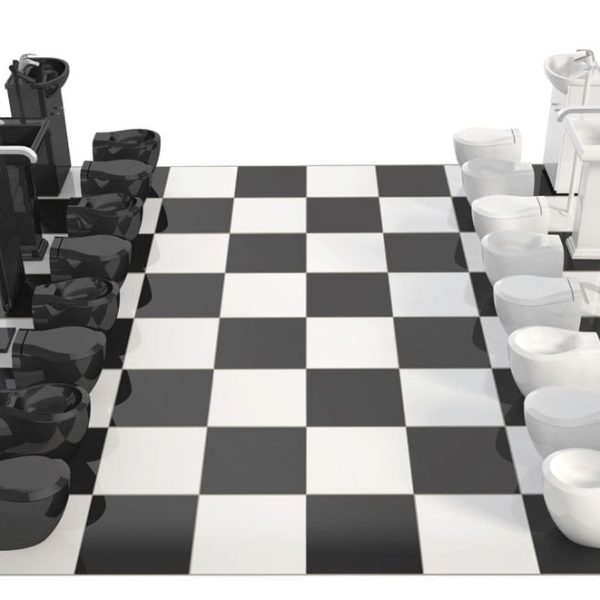Maintaining Cersaie’s longstanding focus on the world’s great architecture, the 2018 Keynote Lecture was delivered by award-winning British architect and designer Lord Richard Rogers, introduced by architecture historian Francesco Dal Co. The 1,800-seat Europauditorium was filled to capacity for the winner of the 2007 Pritzker Architecture Prize, just one of the many awards received during his long career. The hundreds of architects, students and enthusiasts in the audience were greeted by Confindustria Ceramica board member Mauro Vandini, who noted that Rogers’ architecture is “founded on commitment, social well-being and environmental sustainability”. Many of Rogers’ fans queued up at the end of the lecture to meet him and to ask him to sign his autobiography entitled A Place for All People. “Reading it you will find a friend, food for thought, something that will stay with you long after today,” said Francesco Dal Co in his introduction.
Lord Rogers began his enthralling lecture with a declaration: “All architecture is modern in its time and is an expression of those times.” And he concluded with a phrase by musician John Cage, which appears to be its natural consequence: “I can’t understand why people are frightened of new ideas. I’m frightened of the old ones.” Rogers retraced many of the stages in his career and presented some of the most important buildings and projects he worked on, starting out from his signature project, the Pompidou Centre. “I was against it, but luckily the others were in favour. So I accepted the majority decision and we did it,” was how he remembered the origins of Beaubourg. The idea was to reference Times Square in New York and the British Library in London: “The public space is the most important part of the architecture. The public liked it, so the French took this “toy” and used it.”
Other buildings designed by Rogers Stirk Harbour + Partners mentioned by Lord Rogers included Bordeaux Law Courts, Madrid Barajas Airport and Lloyd’s of London.
A fundamental concept shared by all these projects, and one of the unifying themes of the architect’s work, is flexibility, the ability of the building to adapt to new needs. Rogers also repeatedly stressed the social value of his work, including the way we think about cities. “If we don’t want to use our cars, if we want to talk to friends, the city must be compact,” he said. Rogers returned to the concept of the compact city when discussing another of the major urban planning issues of our times: “We’re building fewer houses today than in 1922. Today we have less social housing than after the war. That means that the rich live in cities while everyone else lives outside.”
Lord Rogers (he was knighted in 1991 by Queen Elizabeth II and made Baron Rogers of Riverside in 1996) was born in Florence in 1933 and studied at the Architectural Association School of Architecture in London and at Yale University. After his initial experience with Team 4, the practice he set up together with his first wife Su Rogers and the husband-and-wife team Wendy and Norman Foster, he began a collaboration with Renzo Piano in 1969. In 1971, Piano + Rogers together with Peter Rice, Gianfranco Franchini and Su Rogers won the international competition for the Centre Georges Pompidou in the Beaubourg area of Paris, creating one of the most iconic of all contemporary museum buildings. He founded the Richard Rogers Partnership in 1977 and in 2007 renamed the practice Rogers Stirk Harbour + Partners (RSHP) to reflect Graham Stirk and Ivan Harbour’s contribution to the practice. Over the past forty years, RSHP has attracted critical acclaim and awards with built projects across Europe, the America, Asia and Australia.
Lord Rogers’ best known works besides the Centre Pompidou include the Lloyd’s of London insurance building in London, the European Court of Human Rights building in Strasbourg, the Daimler Complex in Potsdamer Platz in Berlin, the Antwerp Law Courts, the Senedd in Cardiff, the Millennium Dome in London, Madrid-Barajas Airport Terminal 4 and London Heathrow Terminal 5.
In the 1980s and 1990s, Lord Rogers served as a consultant for the Grands Projets de Paris programme launched by French President François Mitterrand, and from 2000 to 2003 he was called as an expert by the mayor of Barcelona for the city’s Urban Strategies Council. He was subsequently asked to serve as advisor to the Mayor of London, Ken Livingstone, and set up the department of Architecture and Urbanism to promote redevelopment and reuse of redundant industrial land and to improve public spaces.
“I shall leave this City not less but more beautiful than I found it was the ancient oath of the Athenian citizen and is the driving ambition behind my work,” Lord Rogers has said.
In addition to the prestigious Pritzker Award received in 2007, Richard Rogers is also the recipient of the RIBA Gold Medal in 1985 and winner of the Thomas Jefferson Memorial Foundation Medal. He won the Praemium Imperiale Prize for Architecture in 2000, the Golden Lion for Lifetime Achievement at the Venice Biennale in 2006 and the Tau Sigma Delta Gold Medal. In 2008, he became a member of The Order of Companions of Honour. The practice received the Stirling Prize in 2006 for the Madrid Barajas Airport Terminal 4 and in 2009 for the Maggie’s Centre in London.
In 2018, Lord Rogers published his autobiography entitled A Place for All People, describing his life, his projects and his ideas for a better society.

December 2021







